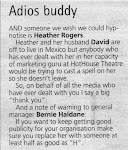
Tuesday, July 7, 2009
Sunday, April 26, 2009
Thursday, April 23, 2009

 Disposing of things:
Disposing of things: We collect so many things, possessions, objects of desire that we do not need and will probably never use. A perfect example was my childhood – which should end some time soon– when I was always on the lookout for some small, interesting and useless thing that I could carry in my pocket; a talisman of sorts. Do not ask why, it just seemed a rooly cool idea @ the time. Wanker!!
Late in 2008 when I realised that Mexico was going to be a reality I was faced with the awful choice of what to take, what to store, and what could find new homes. Everything I own – which is not much anyway except for the above mentioned thingo in my pocket – needed to be put into one of these three categories in such a manner that would not cause regret at some stage later in my life. There was the obvious, easy solution of storing everything thereby delaying the inevitable decisions, but I bit the bullet and started to cull. Heather on the other hand has taken the “store it” path mainly because there is not enough time left to sort through all her stuff.
The first group to face the axe were my books. This was relatively easy as I had already released numerous into the wild through BookCrossing, an on-line organisation that coordinates the free distribution of pre-loved books.
(Read, Recycle, Release with BookCrossing!
Welcome to BookCrossing, where books have adventures of their own. BookCrossing is earth-friendly, and gives you a way to share your books, clear your shelves, and conserve precious resources at the same time. Through our own unique method of recycling reads, BookCrossers give life to books. BookCrossing books are not stagnant dust collectors, but living entities travelling the world as true BookCrossing emissaries. Our books find new readers and introduce them to the wonders of BookCrossing.) Check it out – it is a great way to share your books.
I kept a small number, gave a few special ones to my children and released the rest at the Coffee Mamma van in Dean Street, Albury, to be found by the eclectic (eccentric, epileptic) crowd who get their daily fix there.
Pictures are different – I am keeping them all although the kids are helping by looking after some of them until we return. Impossible to part with them.
(OOOOPS!!! Heather has just read this and informed me that she has culled some of her things! She called me a wanker!)
Tuesday, March 24, 2009
If you want to make god laugh.....


The adventure begins in Melbourne when we join the French container ship CMA CGM Utrillo (1999-built, 30,508-dwt) for the twenty six day voyage to Savannah on the east coast of the southern United States.
As you may know I spent the early part of my working life at sea mucking around in boats. I loved it most of the time and never really managed to extract myself from it. I still get my fix of ships by wandering around ports and harbours when the opportunity arises and have even toyed with the idea of returning…but once I started taking my medication again I realized that it was an unrealistic and unworkable proposition, that is until the idea of going to Mexico by sea entered my fevered brain.
When initially investigating the possibility of traveling by sea in mid 2008 the total cost was $AU5,200, a bit steep when you consider that the return airfare was about $6,000. However we bit the bullet, made the booking and looked forward to a relaxing adventure on the high seas (lashings of food that we did not have to prepare, no domestic chores, free alcohol with lunch and dinner, wild weather, and pirates). This was before the world financial meltdown which saw the Australian dollar fall dramatically against the US dollar and the Euro but the extra surprise was the new pricing structure for the few available cabins which saw us with $11,440 to find instead of the initial $5,200. Whilst I was cautious Heather took the “bugger it” approach so our fates were sealed – we are off on the Utrillo.
The voyage takes us to Savannah in the US via Napier, Tauranga, the Panama Canal and Punta Manzanillo. We could have done it differently by going directly to the west coast of Mexico but the lure of transiting the Panama Canal was too strong: how many people do you know who have steamed through the canal on a cargo ship!?
That roaring you hear is not the rain on the roof but god pissing his boots at the audacity of these mere humans thinking that it will all work out!!
Apart from the obvious attractions of a sea voyage it will be fascinating to see how on-board life has changed over the last quarter century. My memories are of heavy drinking whenever one was off watch and even heavier when in port. This was particularly so in the days prior to containerisation when everything was loaded in slings that could move little more than 3 tons/lift - in some places it was carried on board one bag at a time - several days or weeks could be spent alongside while the vessel loaded/discharged her cargo giving all the crew ample time to drink. This would be done in the bar on board, where the booze was duty free on foreign going ships, or ashore. In retrospect it would seem that alcoholism was a major problem amongst the people I worked with including myself; it was not uncommon to drink a case of beer a day and present for watch still hung-over. Not unexpectedly this culture of excessive drinking led to accidents and, one would think, a breakdown in organizational structure as it was not atypical to find some officers almost permanently incapacitated for much of the trip. For further reading you can find an interesting PhD thesis written by Ian Shea at the University of Tasmania on the topic at http://eprints.utas.edu.au/1023/
It is interesting to note that my last ship, the ORV Franklin, (owned by the Commonwealth Scientific and Industrial Research Organisation, managed by Associated Steamships) was dry but this did not stop some of the crew from drinking a litre bottle of spirits each during a short stop in Truk lagoon, a scuba diving paradise in the Federated States of Micronesia. Some habits die hard.
Other more mundane areas of change will revolve around the level of crewing on a modern vessel. The cabins that are used by the passengers are those now redundant as cost conscious shipping companies reduce the crew levels to the minimum; this is driven in part by financial constraints. Other factors effecting crew size are the high levels of automation in the shipping industry and the outsourcing of much of the maintenance to shore gangs. I am sure there are more which I will discover when I finally settle back into ship board life – is the rigid demarcation between officers and crew still in place? Are titles, uniforms and rank as important as they were 25 years ago? I cannot wait to find out!!
Wednesday, March 4, 2009
2008 - el comienzo mexicano de la odisea











